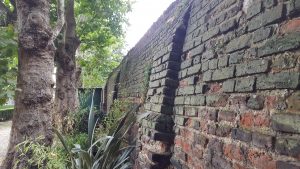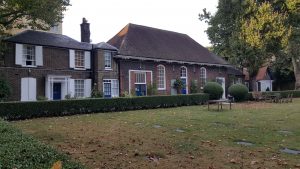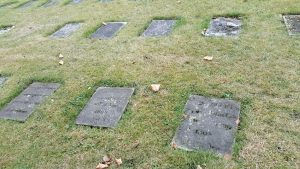The Chairman of the Planning Committee of the Society was invited by the architect acting for the Moravian church to visit the site on 16th September to see their proposals for repairing the walls surrounding the burial ground, for which they have applied to RBKC for permission. He was joined by Jane Dorrell, a member of the Council of the Society, and Tricia Jamieson, a member of the congregation. These are important walls, parts of which enclosed the stable yard of Sir Thomas More’s house.

The Moravian Church in England was founded in 1742 by missionaries who had come to London from Moravia (now in east of the Czech Republic) in search of passage to the British colonies in order to take the Gospel to the communities living there. They realised that there was also work to do in this country and that there were people like the Wesley Brothers with whom to do it. After holding worship meetings in private homes, a permanent chapel was created at Fetter Lane in the City of London. The Fetter Lane chapel was destroyed by bombing in 1941, and in the 1960s the congregation moved to the Chelsea site.

This is where they have worshipped ever since, with the responsibility of looking after “God’s Acre,” which contains the graves of distinguished Moravians. Also buried there is an Inuit boy whom the Moravian missionaries had brought back from Canada.

We were satisfied that the proposals for repairing the walls were well considered and paid due respect to the historical importance of the walls. We saw no reason to object to the planning application.
It is interesting that The Chelsea Society’s Annual Report for 1934/35 records that the Society’s Summer Meeting was held at the Old Moravian Burial Ground on Saturday 6th July 1935, by kind invitation of the well-known artists, Mr. & Mrs. Ernest Gillick. This was the 400th Anniversary of the execution of Sir Thomas More, and an address was given by The Rt. Hon. Lord Russell of Killowen PC, one of the judges of the House of Lords, and President of the More Society. The subject of his address was Sir Thomas More as Lord Chancellor. The assembled company, which included members of the London Society, then proceeded to Chelsea Old Church where a wreath was laid on the More tomb.
The Moravian close formed the northern part of More’s Chelsea property, and the studios of Mr. & Mrs Gillick were where his stables once stood. At the Old Church, More and his family regularly worshipped. He sang in the choir and he built the tomb where his first wife is buried, and where he himself hoped to lie. Perhaps he does, for there is some evidence that his body was taken from the Tower of London by his daughter, Margaret Roper, and re-interred there, where she herself now lies.
Members went then to Crosby Hall for tea. Crosby Place was occupied by Sir Thomas More prior to 1523 on its original Bishopsgate site, and its beautiful Hall now stands on the site of his Chelsea garden.



